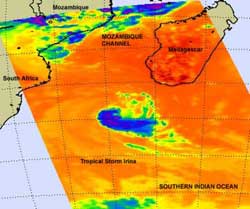NASA sees Tropical Storm Irina heading back toward African mainland

When NASA's Aqua satellite passed over Irina on March 7 at 1053 UTC (5:53 a.m. EST) it captured an infrared image of the storm's cloud top temperatures using the Atmospheric Infrared Sounder (AIRS) instrument. AIRS data showed that the coldest (purple) cloud top temperatures (colder than -63F/-52.7C) that included the bulk of the showers and strongest thunderstorms were on the southern side of the storm. Credit: Credit: NASA/JPL, Ed Olsen<br>
When NASA's Aqua satellite passed over Irina on March 7 at 1053 UTC (5:53 a.m. EST) it captured an infrared image of the storm's cloud top temperatures using the Atmospheric Infrared Sounder (AIRS) instrument. AIRS data showed that the coldest cloud top temperatures (colder than -63F/-52.7C) that included the bulk of the showers and strongest thunderstorms were still on the southern side of the storm, as they were on March 6.
Infrared imagery revealed a “well-defined low-level circulation center with isolated deep convection flaring,” according to the Joint Typhoon Warning Center (JTWC). The JTWC noted that data from the Advanced Microwave Sounding Unit (AMSU) instrument shows “weak deep convective (rising air that forms thunderstorms) banding [of thunderstorms] is limited to the southern quadrant (of the storm) and significant dry air is surrounding the low level center.” Dry air can sap the moisture and strength from a tropical cyclone. The AMSU-A instrument is a 15-channel microwave sounder designed primarily to obtain temperature profiles in the upper atmosphere (especially the stratosphere) and provide a cloud-filtering capability for tropospheric temperature observations.
On March 7 at 1500 UTC (10 a.m. EST), Tropical Cyclone Irina had maximum sustained winds near 45 knots (~52 mph/83.3 kph). Irina had not changed in strength in 24 hours as it looped in the southern Mozambique Channel. Irina is now about 480 nautical miles (~552 miles/~889 km) east-southeast of Maputo, Mozambique. The center is near 29.4 South latitude and 39.1 East longitude. It is now crawling to the west-northwest at just 3 knots. Just 24 hours before, Irina was headed east-northeast.
The forecasters at the Joint Typhoon Warning Center stated that Irina is moving through cool sea surface temperatures near 25 Celsius/77 Fahrenheit (a tropical cyclone needs temperatures of 22.6C/80F to maintain strength) and moderate, westerly vertical wind shear.” Cool waters and moderate-to-strong wind shear are two factors that weaken tropical cyclones.
Irina is now being steered by a low-level subtropical ridge (elongated area) of high pressure, south of the cyclone. That ridge is pushing Irina to the west. Irina is forecast to continue moving westward at sea over the next couple of days and continue to kick up high waves in the southern Mozambique Channel. Residents along the eastern coast of South Africa and Mozambique should keep an eye on the storm as it moves back in their direction over the next couple of days.
Media Contact
More Information:
http://www.nasa.govAll latest news from the category: Earth Sciences
Earth Sciences (also referred to as Geosciences), which deals with basic issues surrounding our planet, plays a vital role in the area of energy and raw materials supply.
Earth Sciences comprises subjects such as geology, geography, geological informatics, paleontology, mineralogy, petrography, crystallography, geophysics, geodesy, glaciology, cartography, photogrammetry, meteorology and seismology, early-warning systems, earthquake research and polar research.
Newest articles

High-energy-density aqueous battery based on halogen multi-electron transfer
Traditional non-aqueous lithium-ion batteries have a high energy density, but their safety is compromised due to the flammable organic electrolytes they utilize. Aqueous batteries use water as the solvent for…

First-ever combined heart pump and pig kidney transplant
…gives new hope to patient with terminal illness. Surgeons at NYU Langone Health performed the first-ever combined mechanical heart pump and gene-edited pig kidney transplant surgery in a 54-year-old woman…

Biophysics: Testing how well biomarkers work
LMU researchers have developed a method to determine how reliably target proteins can be labeled using super-resolution fluorescence microscopy. Modern microscopy techniques make it possible to examine the inner workings…





















